| Listing 1 - 10 of 11 | << page >> |
Sort by
|
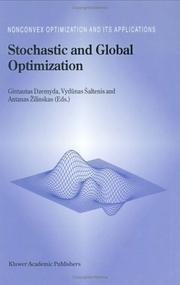
ISBN: 1280201320 9786610201327 0306476487 1402004842 Year: 2002 Publisher: Dordrecht : London : Kluwer Academic,
Abstract | Keywords | Export | Availability | Bookmark
 Loading...
Loading...Choose an application
- Reference Manager
- EndNote
- RefWorks (Direct export to RefWorks)
This volume is dedicated to the 70th birthday of Professor J. Mockus, whose scientific interests include theory and applications of global and discrete optimization, and stochastic programming. The papers for the book were selected because they relate to these topics and also satisfy the criterion of theoretical soundness combined with practical applicability. In addition, the methods for statistical analysis of extremal problems are covered. Although statistical approach to global and discrete optimization is emphasized, applications to optimal design and to mathematical finance are also presented. The results of some subjects (for example, statistical models based on one-dimensional global optimization) are summarized and the prospects for developments are justified.
Mathematics. --- Computers. --- System theory. --- Mathematical optimization. --- Statistics. --- Optimization. --- Statistics, general. --- Systems Theory, Control. --- Theory of Computation. --- Statistics for Engineering, Physics, Computer Science, Chemistry and Earth Sciences. --- Stochastic processes.
Book
ISBN: 1461201071 Year: 2002 Publisher: Boston, MA : Birkhäuser Boston : Imprint: Birkhäuser,
Abstract | Keywords | Export | Availability | Bookmark
 Loading...
Loading...Choose an application
- Reference Manager
- EndNote
- RefWorks (Direct export to RefWorks)
This book is primarily a research monograph that presents in a unified man ner some recent research on a class of hybrid dynamical systems (HDS). The book is intended both for researchers and advanced postgraduate stu dents working in the areas of control engineering, theoretical computer science, or applied mathematics and with an interest in the emerging field of hybrid dynamical systems. The book assumes competence in the basic mathematical techniques of modern control theory. The material presented in this book derives from a period of fruitful research collaboration between the authors that began in 1994 and is still ongoing. Some of the material contained herein has appeared as isolated results in journal papers and conference proceedings. This work presents this material in an integrated and coherent manner and also presents many new results. Much of the material arose from joint work with students and colleagues, and the authors wish to acknowledge the major contributions made by Ian Petersen, Efstratios Skafidas, Valery Ugrinovskii, David Cook, Iven Mareels, and Bill Moran. There is currently no precise definition of a hybrid dynamical system; however, in broad terms it is a dynamical system that involves a mixture of discrete-valued and continuous-valued variables. Since the early 1990s, a bewildering array of results have appeared under the umbrella of HDS, ranging from the analysis of elementary on-off control systems to sophis ticated mathematical logic-based descriptions of large real-time software systems.
System theory. --- Control engineering. --- Computers. --- Applied mathematics. --- Engineering mathematics. --- Vibration. --- Dynamical systems. --- Dynamics. --- Robotics. --- Mechatronics. --- Systems Theory, Control. --- Control and Systems Theory. --- Theory of Computation. --- Applications of Mathematics. --- Vibration, Dynamical Systems, Control. --- Control, Robotics, Mechatronics.
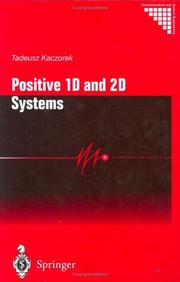
ISBN: 1852335084 9781852335083 1447110978 1447102215 Year: 2002 Publisher: London ; New York : Springer,
Abstract | Keywords | Export | Availability | Bookmark
 Loading...
Loading...Choose an application
- Reference Manager
- EndNote
- RefWorks (Direct export to RefWorks)
In the last decade a dynamic development in positive systems has been observed. Roughly speaking, positive systems are systems whose inputs, state variables and outputs take only nonnegative values. Examples of positive systems are industrial processes involving chemical reactors, heat exchangers and distillation columns, storage systems, compartmental systems, water and atmospheric pollution models. A variety of models having positive linear system behaviour can be found in engineering, management science, economics, social sciences, biology and medicine, etc. The basic mathematical tools for analysis and synthesis of linear systems are linear spaces and the theory of linear operators. Positive linear systems are defined on cones and not on linear spaces. This is why the theory of positive systems is more complicated and less advanced. The theory of positive systems has some elements in common with theories of linear and non-linear systems. Schematically the relationship between the theories of linear, non-linear and positive systems is shown in the following figure Figure 1.
Non-negative matrices --- Linear systems --- Matrices non négatives --- Systèmes linéaires --- Positive systems --- Matrices non négatives --- Systèmes linéaires --- Computer communication systems. --- Control engineering. --- System theory. --- Computer Communication Networks. --- Control and Systems Theory. --- Systems Theory, Control. --- Systems, Theory of --- Systems science --- Science --- Control engineering --- Control equipment --- Control theory --- Engineering instruments --- Automation --- Programmable controllers --- Communication systems, Computer --- Computer communication systems --- Data networks, Computer --- ECNs (Electronic communication networks) --- Electronic communication networks --- Networks, Computer --- Teleprocessing networks --- Data transmission systems --- Digital communications --- Electronic systems --- Information networks --- Telecommunication --- Cyberinfrastructure --- Electronic data processing --- Network computers --- Philosophy --- Distributed processing
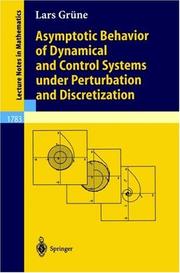
ISBN: 3540433910 3540367845 9783540433910 Year: 2002 Volume: 1783 Publisher: Berlin Springer-Verlag
Abstract | Keywords | Export | Availability | Bookmark
 Loading...
Loading...Choose an application
- Reference Manager
- EndNote
- RefWorks (Direct export to RefWorks)
This book provides an approach to the study of perturbation and discretization effects on the long-time behavior of dynamical and control systems. It analyzes the impact of time and space discretizations on asymptotically stable attracting sets, attractors, asumptotically controllable sets and their respective domains of attractions and reachable sets. Combining robust stability concepts from nonlinear control theory, techniques from optimal control and differential games and methods from nonsmooth analysis, both qualitative and quantitative results are obtained and new algorithms are developed, analyzed and illustrated by examples.
Attractors (Mathematics) --- Differentiable dynamical systems. --- Asymptotic expansions. --- Perturbation (Mathematics) --- Differentiable dynamical systems --- Asymptotic expansions --- Geometry --- Mathematical Theory --- Mathematics --- Physical Sciences & Mathematics --- Dynamics. --- Ergodic theory. --- System theory. --- Numerical analysis. --- Calculus of variations. --- Dynamical Systems and Ergodic Theory. --- Systems Theory, Control. --- Numerical Analysis. --- Calculus of Variations and Optimal Control; Optimization. --- Mathematical analysis --- Systems, Theory of --- Systems science --- Science --- Ergodic transformations --- Continuous groups --- Mathematical physics --- Measure theory --- Transformations (Mathematics) --- Dynamical systems --- Kinetics --- Mechanics, Analytic --- Force and energy --- Mechanics --- Physics --- Statics --- Isoperimetrical problems --- Variations, Calculus of --- Maxima and minima --- Philosophy
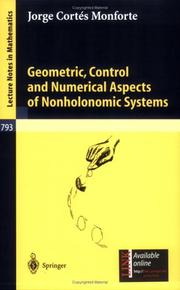
ISSN: 00758434 ISBN: 3540441549 3540457305 9783540441540 Year: 2002 Volume: 1793 Publisher: Berlin Springer-Verlag
Abstract | Keywords | Export | Availability | Bookmark
 Loading...
Loading...Choose an application
- Reference Manager
- EndNote
- RefWorks (Direct export to RefWorks)
Nonholonomic systems are a widespread topic in several scientific and commercial domains, including robotics, locomotion and space exploration. This work sheds new light on this interdisciplinary character through the investigation of a variety of aspects coming from several disciplines. The main aim is to illustrate the idea that a better understanding of the geometric structures of mechanical systems unveils new and unknown aspects to them, and helps both analysis and design to solve standing problems and identify new challenges. In this way, separate areas of research such as Classical Mechanics, Differential Geometry, Numerical Analysis or Control Theory are brought together in this study of nonholonomic systems.
Nonholonomic dynamical systems. --- Geometry, Differential. --- Nonlinear control theory. --- Geometry, Differential --- Nonlinear control theory --- Nonholonomic dynamical systems --- Mathematical Theory --- Geometry --- Mathematics --- Physical Sciences & Mathematics --- Dynamics. --- Ergodic theory. --- Mechanics. --- Mechanics, Applied. --- System theory. --- Dynamical Systems and Ergodic Theory. --- Theoretical and Applied Mechanics. --- Systems Theory, Control. --- Systems, Theory of --- Systems science --- Science --- Applied mechanics --- Engineering, Mechanical --- Engineering mathematics --- Classical mechanics --- Newtonian mechanics --- Physics --- Dynamics --- Quantum theory --- Ergodic transformations --- Continuous groups --- Mathematical physics --- Measure theory --- Transformations (Mathematics) --- Dynamical systems --- Kinetics --- Mechanics, Analytic --- Force and energy --- Mechanics --- Statics --- Philosophy
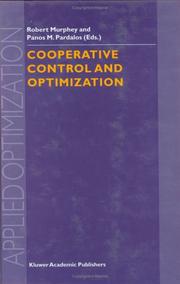
ISBN: 9781402005497 1402005490 9780306475368 9786610200238 1280200235 0306475367 Year: 2002 Publisher: Dordrecht ; Boston : Kluwer Academic Publishers,
Abstract | Keywords | Export | Availability | Bookmark
 Loading...
Loading...Choose an application
- Reference Manager
- EndNote
- RefWorks (Direct export to RefWorks)
A cooperative system is defined to be multiple dynamic entities that share information or tasks to accomplish a common, though perhaps not singular, objective. Examples of cooperative control systems might include: robots operating within a manufacturing cell, unmanned aircraft in search and rescue operations or military surveillance and attack missions, arrays of micro satellites that form a distributed large aperture radar, employees operating within an organization, and software agents. The term entity is most often associated with vehicles capable of physical motion such as robots, automobiles, ships, and aircraft, but the definition extends to any entity concept that exhibits a time dependent behavior. Critical to cooperation is communication, which may be accomplished through active message passing or by passive observation. It is assumed that cooperation is being used to accomplish some common purpose that is greater than the purpose of each individual, but we recognize that the individual may have other objectives as well, perhaps due to being a member of other caucuses. This implies that cooperation may assume hierarchical forms as well. The decision-making processes (control) are typically thought to be distributed or decentralized to some degree. For if not, a cooperative system could always be modeled as a single entity. The level of cooperation may be indicated by the amount of information exchanged between entities. Cooperative systems may involve task sharing and can consist of heterogeneous entities. Mixed initiative systems are particularly interesting heterogeneous systems since they are composed of humans and machines. Finally, one is often interested in how cooperative systems perform under noisy or adversary conditions. In December 2000, the Air Force Research Laboratory and the University of Florida successfully hosted the first Workshop on Cooperative Control and Optimization in Gainesville, Florida. This book contains selected refereed papers summarizing the participants' research in control and optimization of cooperative systems. Audience: Faculty, graduate students, and researchers in optimization and control, computer sciences and engineering.
Decision making. --- Mathematical optimization. --- Control theory. --- Prise de décision --- Optimisation mathématique --- Théorie de la commande --- Mathematics --- Civil & Environmental Engineering --- Engineering & Applied Sciences --- Physical Sciences & Mathematics --- Operations Research --- Calculus --- Calculus of variations. --- System theory. --- Computers. --- Numerical analysis. --- Computer science—Mathematics. --- Calculus of Variations and Optimal Control; Optimization. --- Systems Theory, Control. --- Theory of Computation. --- Numeric Computing. --- Discrete Mathematics in Computer Science. --- Mathematical analysis --- Automatic computers --- Automatic data processors --- Computer hardware --- Computing machines (Computers) --- Electronic brains --- Electronic calculating-machines --- Electronic computers --- Hardware, Computer --- Computer systems --- Cybernetics --- Machine theory --- Calculators --- Cyberspace --- Systems, Theory of --- Systems science --- Science --- Isoperimetrical problems --- Variations, Calculus of --- Maxima and minima --- Philosophy --- Dynamics --- Optimization (Mathematics) --- Optimization techniques --- Optimization theory --- Systems optimization --- Operations research --- Simulation methods --- System analysis --- Deciding --- Decision (Psychology) --- Decision analysis --- Decision processes --- Making decisions --- Management --- Management decisions --- Choice (Psychology) --- Problem solving --- Decision making

ISBN: 0306464594 9786610205516 1280205512 0306469766 9780306464591 Year: 2002 Publisher: New York : Kluwer Academic Publishers,
Abstract | Keywords | Export | Availability | Bookmark
 Loading...
Loading...Choose an application
- Reference Manager
- EndNote
- RefWorks (Direct export to RefWorks)
This book introduces the fundamental concepts and practical simulation te- niques for modeling different aspects of operating systems to study their g- eral behavior and their performance. The approaches applied are obje- oriented modeling and process interaction approach to discrete-event simu- tion. The book depends on the basic modeling concepts and is more specialized than my previous book: Practical Process Simulation with Object-Oriented Techniques and C++, published by Artech House, Boston 1999. For a more detailed description see the Web location: http://science.kennesaw.edu/~jgarrido/mybook,html. Most other books on performance modeling use only analytical approaches, and very few apply these concepts to the study of operating systems. Thus, the unique feature of the book is that it concentrates on design aspects of operating systems using practical simulation techniques. In addition, the book illustrates the dynamic behavior of different aspects of operating systems using the various simulation models, with a general hands-on approach.
Operating systems (Computers) --- Object-oriented methods (Computer science) --- Evaluation --- 681.3*D15 --- -Object development methods (Computer science) --- Object orientation (Computer science) --- Object-oriented development (Computer science) --- Object technology (Computer science) --- 681.3*D15 Software: object-oriented programming --- Software: object-oriented programming --- Computer operating systems --- Computers --- Disk operating systems --- Operating systems --- Operating systems (Computers) -- Evaluation. --- Computer science. --- Computer organization. --- Microprocessors. --- Programming languages (Electronic computers). --- Operating systems (Computers). --- System theory. --- Computer Science. --- Programming Languages, Compilers, Interpreters. --- Operating Systems. --- Processor Architectures. --- Computer Systems Organization and Communication Networks. --- Systems Theory, Control. --- Object development methods (Computer science) --- System design --- Systems software --- Evaluation. --- Computer network architectures. --- Systems theory. --- Systems, Theory of --- Systems science --- Science --- Organization, Computer --- Electronic digital computers --- Minicomputers --- Computer languages --- Computer program languages --- Computer programming languages --- Machine language --- Electronic data processing --- Languages, Artificial --- Philosophy --- Simulation methods. --- Operating systems (Computers) - Evaluation
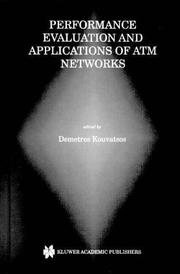
ISBN: 0792378512 9786610206216 1280206217 0306470233 Year: 2002 Publisher: New York : Kluwer Academic Publishers,
Abstract | Keywords | Export | Availability | Bookmark
 Loading...
Loading...Choose an application
- Reference Manager
- EndNote
- RefWorks (Direct export to RefWorks)
Information Highways are widely considered as the next generation of high speed communication systems. These highways will be based on emerging Broadband Integrated Services Digital Networks (B-ISDN), which - at least in principle - are envisioned to support not only all the kinds of networking applications known today but also future applications which are not as yet understood fully or even anticipated. Thus, B-ISDNs release networking processes from the limitations which the communications medium has imposed historically. The operational generality stems from the versatility of Asynchronous Transfer Mode (ATM) which is the transfer mode adopted by ITU-T for broadband public ISDN as well as wide area private ISDN. A transfer mode which provides the transmission, multiplexing and switching core that lies at the foundations of a communication network. ATM is designed to integrate existing and future voice, audio, image and data services. Moreover, ATM aims to minimise the complexity of switching and buffer management, to optimise intermediate node processing and buffering and to bound transmission delays. These design objectives are met at high transmission speeds by keeping the basic unit of ATM transmission - the ATM cell - short and of fixed length.
Computer architecture. Operating systems --- Asynchronous transfer mode. --- Computer networks --- Telecommunication --- Evaluation. --- Traffic. --- Computer networks -- Evaluation. --- Electronic books. -- local. --- Telecommunication -- Traffic. --- Asynchronous transfer mode --- Telecommunications --- Electrical & Computer Engineering --- Engineering & Applied Sciences --- Evaluation --- Traffic --- Computer science. --- Computer communication systems. --- Data structures (Computer science). --- Text processing (Computer science). --- System theory. --- Electrical engineering. --- Computer Science. --- Computer Communication Networks. --- Electrical Engineering. --- Systems Theory, Control. --- Data Structures, Cryptology and Information Theory. --- Document Preparation and Text Processing. --- Computer engineering. --- Systems theory. --- Data structures (Computer scienc. --- Natural language processing (Computer science). --- Data Structures and Information Theory. --- Natural Language Processing (NLP). --- NLP (Computer science) --- Artificial intelligence --- Electronic data processing --- Human-computer interaction --- Semantic computing --- Information structures (Computer science) --- Structures, Data (Computer science) --- Structures, Information (Computer science) --- File organization (Computer science) --- Abstract data types (Computer science) --- Systems, Theory of --- Systems science --- Science --- Electric engineering --- Engineering --- Communication systems, Computer --- Computer communication systems --- Data networks, Computer --- ECNs (Electronic communication networks) --- Electronic communication networks --- Networks, Computer --- Teleprocessing networks --- Data transmission systems --- Digital communications --- Electronic systems --- Information networks --- Cyberinfrastructure --- Network computers --- Philosophy --- Distributed processing --- ATM (Data transmission) --- Broadband communication systems --- Packet switching (Data transmission)

ISBN: 1402011202 0306481448 Year: 2002 Publisher: Dordrecht, Netherlands ; Boston, Massachusetts : Kluwer Academic Publishers,
Abstract | Keywords | Export | Availability | Bookmark
 Loading...
Loading...Choose an application
- Reference Manager
- EndNote
- RefWorks (Direct export to RefWorks)
Physics --- Quantum theory. --- Philosophy. --- Physics. --- Computers. --- Artificial intelligence. --- System theory. --- Mathematical logic. --- Quantum physics. --- Elementary particles (Physics). --- Quantum field theory. --- Elementary Particles, Quantum Field Theory. --- Quantum Physics. --- Artificial Intelligence (incl. Robotics). --- Mathematical Logic and Foundations. --- Systems Theory, Control. --- Theory of Computation. --- Relativistic quantum field theory --- Field theory (Physics) --- Quantum theory --- Relativity (Physics) --- Elementary particles (Physics) --- High energy physics --- Nuclear particles --- Nucleons --- Nuclear physics --- Quantum dynamics --- Quantum mechanics --- Quantum physics --- Mechanics --- Thermodynamics --- Algebra of logic --- Logic, Universal --- Mathematical logic --- Symbolic and mathematical logic --- Symbolic logic --- Mathematics --- Algebra, Abstract --- Metamathematics --- Set theory --- Syllogism --- Systems, Theory of --- Systems science --- Science --- AI (Artificial intelligence) --- Artificial thinking --- Electronic brains --- Intellectronics --- Intelligence, Artificial --- Intelligent machines --- Machine intelligence --- Thinking, Artificial --- Bionics --- Cognitive science --- Digital computer simulation --- Electronic data processing --- Logic machines --- Machine theory --- Self-organizing systems --- Simulation methods --- Fifth generation computers --- Neural computers --- Automatic computers --- Automatic data processors --- Computer hardware --- Computing machines (Computers) --- Electronic calculating-machines --- Electronic computers --- Hardware, Computer --- Computer systems --- Cybernetics --- Calculators --- Cyberspace --- Natural philosophy --- Philosophy, Natural --- Physical sciences --- Dynamics --- Philosophy --- Knowledge, Theory of. --- Epistemology --- Theory of knowledge --- Psychology
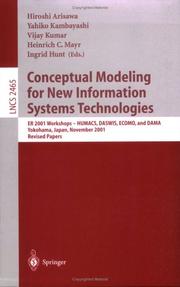
ISBN: 354046140X 3540441220 Year: 2002 Publisher: Berlin ; Heidelberg ; New York : Springer,
Abstract | Keywords | Export | Availability | Bookmark
 Loading...
Loading...Choose an application
- Reference Manager
- EndNote
- RefWorks (Direct export to RefWorks)
The objective of the workshops associated with ER 2001, the 20th International Conference on Conceptual Modeling, was to give participants the opportunity to present and discuss emerging hot topics, thus adding new perspectives to conceptual modeling. This, the 20th ER conference, the first of the 21st century, was also the first one in Japan. The conference was held on November 27-30, 2001 at Yokohama National University with 192 participants from 31 countries. ER 2001 encompasses the entire spectrum of conceptual modeling, from theoretical aspects to implementations, including fundamentals, applications, and software engineering. In particular, ER 2001 emphasized e-business and reengineering. To meet this objective, we selected the following four topics and planned four international workshops: – International Workshop on Conceptual Modeling of Human/Organizational/Social Aspects of Manufacturing Activities (HUMACS 2001) Manufacturing enterprises have to confront a host of demands. The competitive climate, enhanced by communication and knowledge sharing, will require increasingly rapid responses to market forces. Customer demands for higher quality, better services, and lower cost will force manufacturers to reach new levels of flexibility and adaptability. Sophisticated customers will demand products customized to meet their needs. Industries have so far sought to cope with these challenges primarily through advances in traditional capital by installing more powerful hardware and software technology. Attention to the role of humans combined with organizational and social schemes in manufacturing has only been marginal. The workshop HUMACS 2001 aimed to challenge the relevance of this last point.
Database design --- Relational databases --- Computer science. --- Computers. --- Database management. --- Information storage and retrieval. --- Multimedia information systems. --- System theory. --- Computer Science. --- Theory of Computation. --- Systems Theory, Control. --- Database Management. --- Information Systems Applications (incl. Internet). --- Information Storage and Retrieval. --- Multimedia Information Systems. --- Systems, Theory of --- Systems science --- Science --- Computer-based multimedia information systems --- Multimedia computing --- Multimedia information systems --- Multimedia knowledge systems --- Information storage and retrieval systems --- Data base management --- Data services (Database management) --- Database management services --- DBMS (Computer science) --- Generalized data management systems --- Services, Database management --- Systems, Database management --- Systems, Generalized database management --- Electronic data processing --- Automatic computers --- Automatic data processors --- Computer hardware --- Computing machines (Computers) --- Electronic brains --- Electronic calculating-machines --- Electronic computers --- Hardware, Computer --- Computer systems --- Cybernetics --- Machine theory --- Calculators --- Cyberspace --- Informatics --- Philosophy --- 681.3*I --- 681.3*I Computing methodologies --- Computing methodologies --- Conferences - Meetings --- Information theory. --- Systems theory. --- Information storage and retrieva. --- Multimedia systems. --- Communication theory --- Communication --- Information storage and retrieval systems. --- Automatic data storage --- Automatic information retrieval --- Automation in documentation --- Computer-based information systems --- Data processing systems --- Data storage and retrieval systems --- Discovery systems, Information --- Information discovery systems --- Information processing systems --- Information retrieval systems --- Machine data storage and retrieval --- Mechanized information storage and retrieval systems --- Electronic information resources --- Data libraries --- Digital libraries --- Information organization --- Information retrieval --- Application software. --- Application computer programs --- Application computer software --- Applications software --- Apps (Computer software) --- Computer software
| Listing 1 - 10 of 11 | << page >> |
Sort by
|

 Search
Search Feedback
Feedback About UniCat
About UniCat  Help
Help News
News